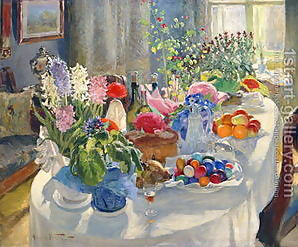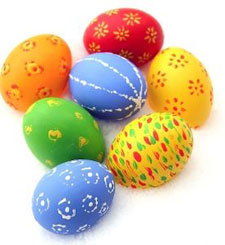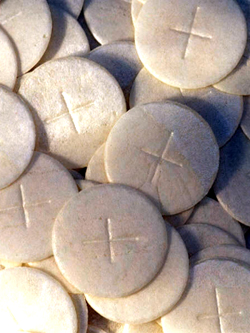 Easter. “Eater” with a full stomach, the inevitable outcome on any
day replete with decorated eggs, chocolate bunnies, ham, lamb, brisket
for the polydenominational and, for the faithful, whatever they have
given up for Lent.
Easter. “Eater” with a full stomach, the inevitable outcome on any
day replete with decorated eggs, chocolate bunnies, ham, lamb, brisket
for the polydenominational and, for the faithful, whatever they have
given up for Lent.
I grew up in a very faithful household—my father was an Episcopal priest and I was devoutly devout, an altar boy from age six and happy for it. The church, near San Diego and which held about 250 souls, was built over a two-year period of volunteer labor by the parishioners, who did everything except the plastering and electrical work. The labor was hard and sweaty, and in honor of all that sweat, my father put an empty beer can in the trench for the foundation. He didn’t put in a full can, he said with a twinkle in his eyes, “because I thought the Good Lord would object to the waste.” The church was an extension of our home, or vice versa—literally (the rectory was about 20 feet away), and figuratively (my mother, father and I folded several hundred palm crosses every year, with enough extra to be saved and burned for use on Ash Wednesday the next year).
When Easter rolled around, my mother boiled up a dozen eggs, which were dipped into various hues, and I hunted for them with gusto. The problem was, one or two hardboiled eggs of any color are enough to eat at one time; they soon are like sawdust in the mouth, and although they quickly grew boring, my parents were Depression-era folks and nothing went to waste.
 Easter. “Eater” with a full stomach, the inevitable outcome on any day replete with decorated eggs, chocolate bunnies, ham, lamb, brisket for the polydenominational and, for the faithful, whatever they have given up for Lent.
Easter. “Eater” with a full stomach, the inevitable outcome on any day replete with decorated eggs, chocolate bunnies, ham, lamb, brisket for the polydenominational and, for the faithful, whatever they have given up for Lent.
I grew up in a very faithful household—my father was an Episcopal priest and I was devoutly devout, an altar boy from age six and happy for it. The church, near San Diego and which held about 250 souls, was built over a two-year period of volunteer labor by the parishioners, who did everything except the plastering and electrical work. The labor was hard and sweaty, and in honor of all that sweat, my father put an empty beer can in the trench for the foundation. He didn’t put in a full can, he said with a twinkle in his eyes, “because I thought the Good Lord would object to the waste.” The church was an extension of our home, or vice versa—literally (the rectory was about 20 feet away), and figuratively (my mother, father and I folded several hundred palm crosses every year, with enough extra to be saved and burned for use on Ash Wednesday the next year).
 When Easter rolled around, my mother boiled up a dozen eggs, which were dipped into various hues, and I hunted for them with gusto. The problem was, one or two hardboiled eggs of any color are enough to eat at one time; they soon are like sawdust in the mouth, and although they quickly grew boring, my parents were Depression-era folks and nothing went to waste. (As a young priest in the 1930s, my father served on the Saskatchewan prairie, where farmers commonly said they had “nothing of everything” and his pay was often a crate of twelve-dozen eggs.)
When Easter rolled around, my mother boiled up a dozen eggs, which were dipped into various hues, and I hunted for them with gusto. The problem was, one or two hardboiled eggs of any color are enough to eat at one time; they soon are like sawdust in the mouth, and although they quickly grew boring, my parents were Depression-era folks and nothing went to waste. (As a young priest in the 1930s, my father served on the Saskatchewan prairie, where farmers commonly said they had “nothing of everything” and his pay was often a crate of twelve-dozen eggs.)
 We had plenty of everything in Southern California in the 1950’s. Easter lunch was always with the same friends we shared Christmas and New Year—a doctor in the congregation and a navy chaplain and their families. The chaplain and his wife, the doctor and his wife, and my father always gave up drinking for Lent, and it was amusing to watch them eagerly mixing martinis the moment they walked into the house. My mother’s sacrifice was chocolate.
We had plenty of everything in Southern California in the 1950’s. Easter lunch was always with the same friends we shared Christmas and New Year—a doctor in the congregation and a navy chaplain and their families. The chaplain and his wife, the doctor and his wife, and my father always gave up drinking for Lent, and it was amusing to watch them eagerly mixing martinis the moment they walked into the house. My mother’s sacrifice was chocolate.
But physical food is not what I really want to talk about. Rather, the spiritual meal is what interests me. I was confirmed when I was eight, able to spout at a moment’s notice that sacrament means “an outward and visible sign of an inward and spiritual grace given unto us; ordained by Christ himself, and a means whereby we receive the same, and a pledge to assure us thereof.”
 An acolyte every Sunday morning, I was adept at quickly counting the congregation (and in later years checking to see if a particular girl I liked was there) to approximate the number of communicants as I held the ciborium with the communion wafers. I’d whisper the number to my father, who withdrew accordingly and consecrated them in the next prayer, making them the symbol of Christ’s broken body.
An acolyte every Sunday morning, I was adept at quickly counting the congregation (and in later years checking to see if a particular girl I liked was there) to approximate the number of communicants as I held the ciborium with the communion wafers. I’d whisper the number to my father, who withdrew accordingly and consecrated them in the next prayer, making them the symbol of Christ’s broken body.
Those wafers, made of flour and water by nuns in Canada, were the WASP version of matzo, something that would not cross my lips for many years to come. Off-white and brittle, they melted on the tongue, leaving a bland but discernable flavor that I quite liked. So much so, that sometimes when going to see my father in his office, just off the sanctuary, I’d go through the door on the other side of the church and into the sacristy, where the tins of quarter-sized wafers and larger priest’s Hosts were kept, and grab a dozen or so. Because they were unconsecrated, they were no different than any snack, and I’d pop them in my mouth and chomp with guiltless gusto.
And I didn’t have to give them up for Lent.
Eric Lax’s books include Conversations with Woody Allen, and The mold in Dr. Florey’s Coat: The Story of the Penicillin Miracle. His latest book, Faith, Interrupted: A Spiritual Journey, will be published by Knopf on April 6.

